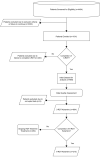Safety, effectiveness and tolerability of sublingual ketamine in depression and anxiety: A retrospective study of off-label, at-home use
- PMID: 36245861
- PMCID: PMC9554222
- DOI: 10.3389/fpsyt.2022.992624
Safety, effectiveness and tolerability of sublingual ketamine in depression and anxiety: A retrospective study of off-label, at-home use
Abstract
Intravenous and intranasal ketamine have been shown to be effective therapeutic options in patients suffering from treatment-resistant depression (TRD). The use of sublingual (SL), rapid dissolve ketamine tablets (RDT) offers a novel approach for delivery for mental health indications. This study assessed the effectiveness and safety of self-administration of off-label, SL, rapid dissolve ketamine tablets (RDT) at-home for depression and anxiety. Intake scores on the Generalized Anxiety Disorder Screener (GAD-7) and Patient Health Questionnaire (PHQ-9) were compared to scores after treatments of three doses of ketamine RDT, and after six doses of ketamine RDT. After three doses of SL ketamine, 47.6% of patients showed a significant decrease in PHQ-9 scores, and 47.6% of patients showed a significant reduction in GAD-7 scores. Reduction rates were higher in those patients who completed a clinically recommended six doses of RDT ketamine. This study demonstrates that SL ketamine is a novel, safe, and effective treatment for TRD and treatment-resistant anxiety. SL ketamine offers an alternative therapeutic approach to IV ketamine when treating those with TRD.
Keywords: anxiety; depression; ketamine; sublingual; treatment resistant depression (TRD).
Copyright © 2022 Hassan, Struthers, Sankarabhotla and Davis.
Conflict of interest statement
Authors KH, AS, and PD hold restricted shares of Nue Life Health, P.B.C. The remaining author declares that the research was conducted in the absence of any commercial or financial relationships that could be construed as a potential conflict of interest.
Figures
Similar articles
-
At-home, sublingual ketamine telehealth is a safe and effective treatment for moderate to severe anxiety and depression: Findings from a large, prospective, open-label effectiveness trial.J Affect Disord. 2022 Oct 1;314:59-67. doi: 10.1016/j.jad.2022.07.004. Epub 2022 Jul 6. J Affect Disord. 2022. PMID: 35809678 Clinical Trial.
-
Clinical Effectiveness of Intravenous Racemic Ketamine Infusions in a Large Community Sample of Patients With Treatment-Resistant Depression, Suicidal Ideation, and Generalized Anxiety Symptoms: A Retrospective Chart Review.J Clin Psychiatry. 2022 Sep 12;83(6):21m14336. doi: 10.4088/JCP.21m14336. J Clin Psychiatry. 2022. PMID: 36112599
-
Role of Ketamine in the Treatment of Psychiatric Disorders.Health Psychol Res. 2021 Jun 22;9(1):25091. doi: 10.52965/001c.25091. eCollection 2021. Health Psychol Res. 2021. PMID: 35106397 Free PMC article. Review.
-
A survey of drug liking and cravings in patients using sublingual or intranasal ketamine for treatment resistant depression: A preliminary evaluation of real world addictive potential.Front Psychiatry. 2022 Nov 17;13:1016439. doi: 10.3389/fpsyt.2022.1016439. eCollection 2022. Front Psychiatry. 2022. PMID: 36465297 Free PMC article.
-
A comparison of the safety, feasibility, and tolerability of ECT and ketamine for treatment-resistant depression.Expert Opin Drug Saf. 2022 Jun;21(6):745-759. doi: 10.1080/14740338.2022.2049754. Epub 2022 Mar 14. Expert Opin Drug Saf. 2022. PMID: 35253555 Review.
Cited by
-
Oral and Intranasal Ketamine Use in Treatment-Resistant Catatonia: A Clinical Case Report.Am J Case Rep. 2023 Apr 25;24:e939530. doi: 10.12659/AJCR.939530. Am J Case Rep. 2023. PMID: 37095688 Free PMC article.
-
A randomized, double-blind, placebo-controlled, Phase 1 study to investigate the safety, tolerability, pharmacokinetics and pharmacodynamics of an immediate-release oral ketamine capsule in healthy volunteers.J Psychopharmacol. 2025 Jun;39(6):545-558. doi: 10.1177/02698811251340925. Epub 2025 Jun 20. J Psychopharmacol. 2025. PMID: 40539366 Free PMC article. Clinical Trial.
-
At-home, telehealth-supported ketamine treatment for depression: Findings from longitudinal, machine learning and symptom network analysis of real-world data.J Affect Disord. 2024 Sep 15;361:198-208. doi: 10.1016/j.jad.2024.05.131. Epub 2024 May 27. J Affect Disord. 2024. PMID: 38810787 Free PMC article.
-
The Montreal model: an integrative biomedical-psychedelic approach to ketamine for severe treatment-resistant depression.Front Psychiatry. 2023 Sep 19;14:1268832. doi: 10.3389/fpsyt.2023.1268832. eCollection 2023. Front Psychiatry. 2023. PMID: 37795512 Free PMC article.
-
Beyond therapeutic potential: a systematic investigation of ketamine misuse in patients with depressive disorders.Discov Ment Health. 2024 Jul 1;4(1):23. doi: 10.1007/s44192-024-00077-2. Discov Ment Health. 2024. PMID: 38951348 Free PMC article. Review.
References
-
- Villarroel MA. Symptoms of depression among adults: United States, 2019. NCHS Data Brief . (2020) 1–8. Available online at: https://www.cdc.gov/nchs/products/databriefs/db379.htm (accessed September 20, 2022). - PubMed
-
- Brody DJ. Prevalence of depression among adults aged 20 and over: United States, 2013–2016. NCHS Data Brief . (2018) 1–8. Available online at: https://www.cdc.gov/nchs/products/databriefs/db303.htm (accessed September 20, 2022). - PubMed
LinkOut - more resources
Full Text Sources



